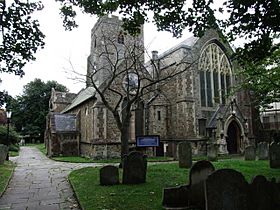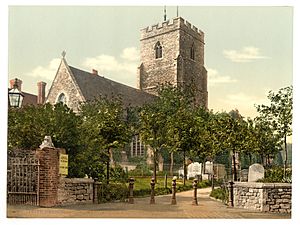St Mary and St Eanswythe's Church, Folkestone facts for kids
Quick facts for kids St Mary and St Eanswythe’s Church, Folkestone |
|
|---|---|

View from the west
|
|
| 51°4′46″N 1°10′54″E / 51.07944°N 1.18167°E | |
| OS grid reference | TR 229 359 |
| Location | Folkestone |
| Country | United Kingdom |
| Denomination | Church of England |
| Website | http://stmaryandsteanswythe.org/ |
| Architecture | |
| Heritage designation | Grade II* |
| Designated | 5 December 1949 |
| Administration | |
| Deanery | Elham Deanery |
| Diocese | Diocese of Canterbury |
St Mary and St Eanswythe's Church is an old and important church in Folkestone, Kent, England. It's located near the cliffs overlooking the English Channel. Some parts of the church are from the 1200s, but most of it was rebuilt in the 1800s. It's special because it has a tower in the middle of the building. This church is a Grade II* listed building, which means it's very important historically and architecturally.
Contents
Who Was St Eanswythe?
St Eanswythe was an Anglo-Saxon princess. She was the granddaughter of King Æthelberht of Kent, who was one of the first English kings to become a Christian. Her father was King Eadbald of Kent, who ruled from 616 to 640. Eanswythe was born around the year 630. People believe she was the leader, or abbess, of a nunnery (a place where nuns live) right here in Folkestone.
The nunnery where St Eanswythe lived was later destroyed. It might have fallen into the sea or been attacked by Vikings in 867. After some rebuilding, a new monastery called Folkestone Priory was built in 1138. It had a church dedicated to St Mary and St Eanswythe. This church is the foundation of the building you see today. On September 12, 1138, the bones of St Eanswythe were brought into this new church. The building was damaged by a fire in 1216 but was fixed up in 1220 and made bigger in 1236.
Changes Over the Years
Even though the church was largely rebuilt in the 1800s, you can still see parts of the older church. For example, the arches in the chancel (the area around the altar) are from the 1200s. The lady chapel (a special chapel north of the chancel), St Eanswythe's chapel (south of the chancel), and the arches of the tower are from the 1400s.
Most of the church was rebuilt when Canon Matthew Woodward was the vicar (the priest in charge) from 1851 to 1898. The main part of the church, called the nave, and the north aisle were rebuilt in the 1850s by an architect named R. C. Hussey. The large window at the west end and the entrance porch were added in 1872 by Stallwood. The south chancel aisle and transept (the arms of the cross-shaped church) were rebuilt in 1869, and the south aisle was rebuilt in 1974. The beautiful windows near the altar and in the Lady Chapel were made by C. E. Kempe.
Finding St Eanswythe's Relics
In 1885, during some repairs to the church, a special container called a reliquary was found. It was hidden in a small space in the walls near the altar. From its decorations, experts believed it was from the 1100s. Inside, there were the bones of a young woman who had died in the 600s. Because of where the reliquary was found, people thought these were the remains of St Eanswythe.
The bones were placed back in the same spot, and the niche was covered with a brass door and a grille. In early 2020, scientists studied the bones again and confirmed that they almost certainly belonged to St Eanswythe. The remains were finally put back into the niche in a specially designed reliquary in November 2024.
The Church Organ
We know that there was an organ in the church as early as 1528. It was rebuilt several times in the 1800s. The current organ was built in 1894 by William Hill & Sons of London. It was later rebuilt and made bigger in 1930 by Hill, Norman & Beard, and it now has 39 different sounds, or "stops."
The Churchyard
In December 2023, King Charles III gave special permission for a local boy named William Brown, who was sadly killed in an accident, to be buried in the churchyard. This was unusual because the churchyard had been closed to new burials for a long time. This special permission is called a 'burial ground variation order' and is advised by the Privy Council.


